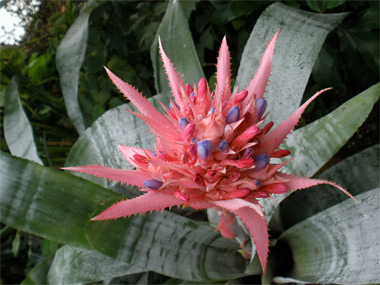
Beautiful life -- This example of the plant aeschmea fasciata is one of more than 20,000 such images featured in an online database known as “phytoimages,” hosted by a researcher at Southern Illinois University Carbondale. Daniel Nickrent, a professor of plant biology, created the site, which he created using money left behind by Walter Welch, a former plant biologist at SIUC. (Photo provided) Download Photo Here
November 12, 2010
Researcher helps uncover new genus of plants
CARBONDALE, Ill -- Daniel Nickrent has collected, organized and electronically published thousands of high-quality photos of various plants since 2006. For the Southern Illinois University Carbondale professor of plant biology, amassing the database is a way of not only moving current research forward, but also acknowledging the foresight and generosity of previous SIUC researchers.
Nickrent recently added the 20,000th image to the online database, known as “PhytoImages” and found at http://www.phytoimages.siu.edu/. And, as it turned out, it was a doozey.
Nickrent, who specializes in parasitic plants, was part of team that recently discovered an entirely new genus of plants. Pictures of this new plant, named “Hondurodendron,” or “tree of Honduras,” provided a nice way to celebrate the database’s growing relevance while also marking an important discovery.
“This was a true international effort,” Nickrent said. “It’s a really neat family that the natives thought was guava. But it’s completely different and not even related to guava. When I saw it I thought we had something new on our hands and the molecules confirmed it.”
New species discoveries are relatively common, but discovering a new genus, which represents an entirely unique group of species, is much more rare. Many researchers will spend their entire career without discovering even one new genus.
Nickrent, however, has been involved with identifying and naming three new genera, including this most recent find. Researchers describe this species, known as Hondurodendron urceolatum (the specific name means “shaped like a pitcher or urn”), as a 40-foot-tall tree with “minute male and female flowers less than 1 eighth-inch wide.”
The thing that really caught their eye, however, was the unusual “fruit” of the tree, which they describe as about 1-inch wide and tightly wrapped in protective covering known as a calyx that enlarges greatly as it matures.
Along with the most recent discovery, which was published recently in the Annals of the Missouri Botanical Garden, Nickrent is perhaps best known for his work with the so-called “corpse flower,” a large, colorful parasitic plant known as Rafflesia, which emits the horrible scent of rotting flesh. The plant grows deep in the jungles of Southeast Asia and elsewhere, and Nickrent has recently published a new species in that genus, as well.
His photo database, however, serves as a collection and sharing point for much of his work, as well as that of other researchers who send him images. All the images include geo-referencing data that indicate on a map exactly where the plants were photographed.
Nickrent started the database four years ago using seed money supplied by Walter B. Welch, an SIUC plant biologist who worked at the University from 1938 to 1969. Welch left some money to SIUC to curate the more than 12,000 color slides he photographed and left behind.
“Walter left the slides and little bit of money, and over the years it became more money,” Nickrent explained. With the explosion of the Internet, however, Nickrent wanted to share Welch’s photos with a wider audience than he thought Welch might have imagined.
To do so, he used the donation to purchase a server and the “PhytoImages” site was born. Today it is home to more than 20,000 images, including 1,031 digitized from the Welch collection and another 9,000 from Nickrent. Researchers from all over the world also send photos for the collection, swelling its volume and providing an invaluable online resource for plant biologists everywhere.
Kevin Nixon, a colleague of Nickrent’s at Cornell University, designed much of the software used by the site, which is set up for research and is a much better way to present such information than other common photo-sharing sites, Nickrent said.
“Our site is set up for scientific research. The images are also tied into Google Maps, which gives information about exactly where each plant was photographed,” Nickrent said. The database is also searchable by several parameters including keyword. Eventually, researchers may even be able to search it by visual characteristics, such as color or shape.
“It is a really powerful tool,” Nickrent said.
Welch’s photos also provide important historical clues about the recent past in terms of plant diversity and how it’s changed. Many of his photos were taken in the southwestern United States and Florida, prior to building booms that have changed plant distributions in those areas.
“The slides show what was there before cities spread and developed,” he said. “Knowing what was there is sometimes just as important to researchers when trying to mark declines in species.”
The site is only destined to grow in volume, with Nickrent currently poring over other slide collections he has inherited. The task is time-consuming, as many images must be classified and retouched in photo software before he adds them to the database.
Eventually, Nickrent foresees tying the database to software that will allow researchers in the field to access and contribute to it using mobile devices and smart phones.
“Could ol’ Walter have ever guessed his images would be the start of something like this at SIUC?” Nickrent mused. “I don’t know, but I think he would like that all these slides are on the Web with this interface. I think he would be pleased.”
